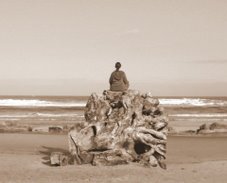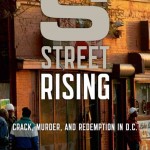A few days ago, I listened to the interview of Ruben Castaneda, author of a new book, S Street Rising: Crack, Murder and Redemption in D.C. It’s a memoir of a neighborhood and a city during one of its most stressed times. It is also the story of the author, who ~ while reporting for the Washington Post on Marion Barry’s (the then-sitting mayor of DC) crack-smoking habit ~ was an active crack addict himself. The interview was compelling in its depiction of our nation’s capitol at the height of the crack epidemic. I knew some of which he spoke because I was there.
In 1991, I lived a few blocks from the epicenter that Castaneda describes. I lived near the U-Street Metro station, which had just opened but hadn’t yet dispersed the “ladies of the night” that walked the neighborhood. This was before it became gentrified ~ or given my presence, as an out-of-work, white college-grad hoping to find work in social services, it must have just been starting. Now, it is a hopping cultural mecca, much like it was during the same time period as the Harlem Renaissance, and not at all like it was after the riots in 1968 after the assassination of Dr. King.
When I was there it was more like the tail end than the height – crack was raging still, but just not at its apogee. I remember, too, that heroin was on the scene again, or still ~ insidious as it always is, sometimes taking a backseat to the new, sexy drug on the market, but always there, always outlasting that new sexy thang, ready to step back on center stage and take more life.
For over a year and a half, I worked at a homeless shelter just six blocks from the Capitol building. It was the only job where I have been officially reprimanded. It is the only job where I was told I had to change my clothes (on my first day, I had dressed down so as to be more accessible to the residents, but I was told by the shelter director that I was being a poor role model and should dress business-like in order to inspire the residents and prepare them for what work life looks like – for realz). It is the only job on which I was physically assaulted (punched; ended up more startled than hurt). So it may sound funny when I say this, but it was one of my favorite jobs (so far).
I am thankful for all the different edges that job brought me to – encountering and resisting racism; encountering my own racism and being called on it; rebelling with cause against unjust treatment of workers and residents; breaking rules to try to save the life of a child (which sounds melodramatic, but was nonetheless real, and devastating); hitting my head against a brick wall of homophobia amongst the staff in a context where there was a lot of lesbian life happening among the residents; and crossing cultural and interpersonal chasms through vulnerability and authenticity.
It was also my first (but certainly not my last) explicit experience of being witness to individual lives of tragedy, trauma, and occasional triumph. One of the clients I worked with froze to death at a bus stop outside the Department of Housing and Urban Development. Though some of my other jobs had me thinking this way, at this one I became convinced – and still hold this belief – that if we could end incest, we would vastly decrease – if not eradicate — addiction and homelessness. Nearly every resident I met – it was a shelter for women – had been sexually abused, certainly as an adult, and more often than not, as a child. Still, there were stories of triumph – like the two overnight workers ~ Ethel and Yvonne ~ who had been residents of the shelter at one point in their lives, were in active recovery, paying it forward.
There are many of these residents whose memory has taken up residence in my heart and head. Ardene, who OD’d. An old lesbian couple – Mary and Eleanor – whom I visited when Mary was placed in the city’s old, dilapidated psychiatric hospital. The Butch who was knocked up and gave birth to a little boy who played a huge role in my life and now doesn’t. The little lost old woman who was dying of congestive heart failure and did not know from whence she came — it turns out it was the Midwest and she got to see her family before she died. And then there was Renee:
Miracles come grudgingly
Don’t just happen
Don’t just descend upon us
From some spiritual high-up plane
Trumpets blaring as white-faced angels
Proclaim imminent arrival.
Miracles don’t just ease in and out of our lives
Making of us better citizens,
steadfaster friends,
kinder bodhisattvas,
gentler lovers,
surer seekers.
They emerge, slowly,
Inch by torturous inch.
Hesitant, even hostile,
A reluctant configuration of
Instinct and happenstance.
Miracles are not volcanoes
but they erupt from an inner core
Hot, festering, greedy
Burning with earthbound violence designed to
rip the ground out from under.
I have known a miracle.
Impulsive explosions that regularly barred her from shelter
A crack habit showing no signs of abating
Desperation disguised as freckles dotting her haunted yellow cheeks.
Month after month
She sat across from me
Scratched metal desk
delineating our separate lives.
She got in my face:
“I know which car is yours.”
She pointed to my face:
“I know which scar will go where.”
Her rage bubbling wildly,
untempered by a true target.
Instead of slashing my tires, somehow,
Somehow,
She told me her story:
Cast iron pan to his head,
after nighttime visits from a phantom father.
Weeping on a curb, behind her a burnt-out shell of a house.
A daughter torn from her adolescent arms,
never seen again.
I am not sure which is the miracle:
Her very survival
or that in this tormented place,
dank with our own ghosts,
we found each other long enough to give light.
I wrote this poem nearly two decades ago. I am always thrilled to share it, for it is part of my intention to continue to witness the life of this woman. I don’t know what happened to Renee. I suspect she succumbed to her addiction. It certainly seemed to be going in that direction the last time we encountered each other. Maybe she experienced the same kind of resurrection that S Street neighborhood is experiencing. Maybe she experienced the same kind of redemption that Ruben Castaneda experienced, in which he kicked the habit and came back to the S Street community, even preaching at the neighborhood church on Easter.
Or maybe, just maybe, each time I share this poem, and each time you read it, anyone reads it, Renee is resurrected and we all take part in her, and our own, redemption.


